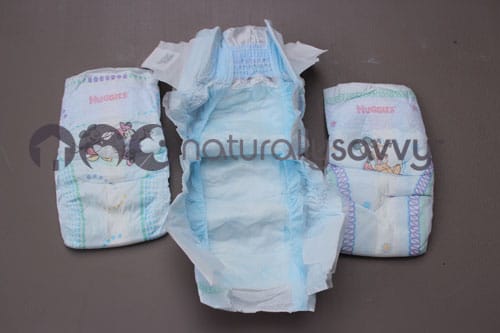
I’m well versed in the world of baby diapers, my youngest of three is now two years old. As a parent, I take diapers seriously-after all, my little ones were in them for 24 hours a day and I didn’t want my baby’s delicate skin to be in contact with dangerous chemicals. I’ve learned a lot about diapers over the years and I’m thankful that today we have safe alternatives.
Conventional Baby Diaper Concerns
Babies will go through 5,000 to 8,000 diapers before they move on to underwear, yet manufacturers are not required to disclose ingredients. Baby diapers are bleached with chlorine dioxide, and although it is technically "chlorine free", it still releases dioxins into the environment. Dioxins are carcinogenic and affect the reproductive and immune systems.
The absorbent center of diapers is made from sodium polyacrylate (SAP), a solidified gel that’s formed when water is poured into a container with sodium polyacrylate powder. That’s what makes diapers so absorbent. SAP was once used in tampons and was primarily responsible for Toxic shock syndrome (TSS). Although sanitary pads and diapers have not been linked to TSS, SAP can irritate the skin and can cause rashes and staph infections.
Synthetic fragrance, dyes, and lotions in baby diapers expose babies to dangerous chemicals. One 1999 study, published in Archives of Environmental and Occupational Health found that test rats exposed to emissions from disposable diapers experienced impaired breathing.
My children's health was reason enough to think twice about diapers, but the environment is another concern. People use disposable diapers for convenience, but they produce a huge amount of waste and they won’t break down for 500 years. They also contain human waste, which is laced with viruses and bacteria that seep into our groundwater.
Better Diaper Choices for Your Little Ones
Luckily, I’ve found a number of good diaper alternatives for parents and soon-to-be parents to consider. In my opinion, unbleached, organic cotton cloth diapers are the way to go. However, [full disclosure] I prefered using unbleached, latex-free, petroleum-free, fragrance-free and chlorine-free disposable diapers. Although it is not the perfect environmental solution, it is one that worked well for me and my lifestyle. I was a loyal Seventh Generation user myself.
However, if cloth is your preference, there are many brands you can consider trying including: Kissaluvs Organic Cotton/Hemp Fitted Diaper, Growing Greens Organic One-Size Fitted Diaper, G-Diapers, and Bummis Organic Cotton Unbleached Pre-fold Diapers, but there are so many out there from which to choose.
Incontinence Diapers
Adult incontinence diapers present a lot of the same issues that conventional baby diapers do including dye, synthetic fragrance, and plastic as well as absorbency gel. They may also contain dioxins as a result of the bleaching process. The only safe alternative I came was adult cloth diapers.
Have you come across other safe alternatives to conventional adult diapers on the market? If so, leave a comment, I’d love to hear your opinions.
Image credit: Andrea Donsky




